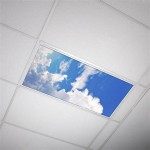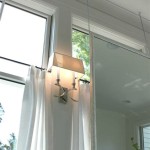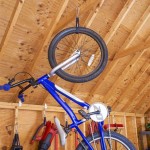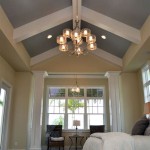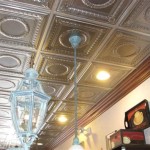Installing a Ceiling Fan on Sloped Walls: A Comprehensive Guide
Installing a ceiling fan on a sloped or angled ceiling presents a unique set of challenges compared to a standard flat ceiling installation. However, with careful planning, the right equipment, and a methodical approach, homeowners can successfully install a ceiling fan and enjoy its benefits, including improved air circulation and energy efficiency. This article provides a detailed guide to navigating the complexities of sloped ceiling fan installation, outlining the necessary preparations, equipment selection, and step-by-step procedures to ensure a safe and functional result.
The primary concern when installing a ceiling fan on a sloped ceiling is ensuring the fan hangs correctly and operates safely. The angle of the ceiling requires specialized hardware and techniques to prevent the fan from wobbling, hitting the ceiling, or causing structural damage. Ignoring these considerations can lead to a noisy and inefficient fan, or even a dangerous situation. Therefore, a thorough understanding of the specific requirements of sloped ceiling installations is crucial before beginning the project.
Key Point 1: Assessing the Slope and Selecting the Appropriate Mounting Hardware
The first step in installing a ceiling fan on a sloped ceiling is to accurately measure the angle of the slope. This measurement is critical for selecting the correct type of mounting hardware. The slope is typically expressed in degrees, and a simple angle finder or level with an angle measurement feature can be used to determine the angle accurately. Most ceiling fan mounting kits designed for sloped ceilings specify the maximum angle they can accommodate. Exceeding this angle can compromise the stability and safety of the installation.
Several types of mounting options are available for sloped ceilings, each designed for different angle ranges and installation scenarios. The most common options include:
Sloped Ceiling Adapters: These adapters are designed to compensate for the angle difference between the ceiling and the fan's downrod. They typically consist of a pivoting ball joint that allows the fan to hang vertically, regardless of the ceiling's slope. Sloped ceiling adapters are generally suitable for slopes up to 45 degrees, but specific models may accommodate steeper angles. It's vital to check the manufacturer's specifications to ensure compatibility with the measured ceiling angle.
Downrods: Using a longer downrod is often necessary for sloped ceilings. A longer downrod provides sufficient clearance between the fan blades and the ceiling, preventing the blades from hitting the ceiling and ensuring proper airflow. The required downrod length depends on the ceiling's height and the angle of the slope. Generally, the higher the ceiling and the steeper the slope, the longer the downrod needed. Manufacturers often provide guidelines for determining the appropriate downrod length based on these factors.
Universal Ceiling Fan Mounting Brackets: Some universal mounting brackets are designed to be adaptable to both flat and sloped ceilings. These brackets often feature adjustable components that allow them to be configured to accommodate various ceiling angles. However, it's crucial to carefully review the bracket's specifications to ensure it's suitable for the specific slope and weight of the ceiling fan.
In addition to selecting the correct type of mounting hardware, it's essential to ensure the electrical box in the ceiling is rated to support the weight of the ceiling fan. Standard electrical boxes are often not designed to handle the dynamic forces generated by a rotating ceiling fan. Using an inadequate electrical box can lead to the box breaking free from the ceiling, creating a dangerous situation. Therefore, a fan-rated electrical box, securely mounted to a structural member in the ceiling, is a non-negotiable requirement.
Furthermore, the wire connecting the fan to the electrical box must be appropriately sized for the fan's electrical load. Using undersized wire can cause overheating and potentially lead to a fire. Consult the ceiling fan's installation manual and local electrical codes to determine the correct wire gauge for the fan's amperage rating. If unsure, consulting with a qualified electrician is always recommended.
Key Point 2: Preparing the Installation Site and Ensuring Safety
Before starting the installation process, it’s crucial to prepare the site and prioritize safety. This involves gathering the necessary tools and equipment, disconnecting the power supply to the circuit, and ensuring a safe working environment.
The following tools and equipment are typically required for installing a ceiling fan on a sloped ceiling:
Screwdriver Set: A variety of screwdrivers, including Phillips head and flathead, are necessary for securing the mounting hardware and connecting the electrical wiring.
Wire Strippers: Wire strippers are essential for safely removing the insulation from the electrical wires without damaging the conductors.
Wire Connectors (Wire Nuts): Wire connectors are used to securely join the electrical wires together. Ensure the connectors are appropriately sized for the gauge and number of wires being connected.
Electrical Tape: Electrical tape is used to insulate and protect the wire connections.
Pliers: Pliers are useful for gripping and manipulating wires and hardware.
Voltage Tester: A voltage tester is crucial for verifying that the power supply to the circuit is completely disconnected before working on the electrical wiring.
Angle Finder or Level with Angle Measurement: As previously mentioned, an angle finder is needed to accurately measure the slope of the ceiling.
Ladder: A sturdy ladder is necessary to safely reach the ceiling and work at the installation site. Ensure the ladder is placed on a stable and level surface.
Drill (Optional): A drill may be needed to create pilot holes for screws, especially if the ceiling is made of hard material.
Stud Finder: A stud finder can help locate the structural supports in the ceiling for mounting the electrical box.
Safety Glasses: Safety glasses are essential for protecting the eyes from debris that may fall during the installation process.
Work Gloves: Work gloves provide a better grip and protect the hands from sharp edges.
Once the tools and equipment are gathered, the next step is to disconnect the power supply to the circuit you will be working on. This can be done by turning off the corresponding circuit breaker in the electrical panel. It’s imperative to double-check that the power is off using a voltage tester before touching any wires. Never assume the power is off simply because the circuit breaker is in the “off” position.
Before proceeding further, ensure the working area is well-lit and free of obstructions. Cover the floor beneath the installation site to protect it from dust and debris. If possible, have an assistant present to help with lifting and maneuvering the ceiling fan.
Removing any existing light fixture is also a critical step. Carefully disconnect the electrical wiring, making sure to label the wires before disconnecting them. This will simplify the reconnection process later. Secure the wires with wire connectors to prevent them from accidentally touching each other or the metal electrical box. Remove the existing mounting bracket and prepare the ceiling for the new fan-rated electrical box and mounting hardware.
Key Point 3: Performing the Installation and Ensuring Proper Functionality
With the site prepared and safety precautions in place, the installation process can begin. This involves installing the fan-rated electrical box, attaching the mounting bracket, assembling the ceiling fan, and connecting the electrical wiring.
Installing the Fan-Rated Electrical Box: If an existing fan-rated electrical box is not already in place, it’s essential to install one. Locate a structural member (joist or beam) in the ceiling using a stud finder. The electrical box must be securely attached to this structural member to support the weight of the ceiling fan. Some fan-rated electrical boxes come with adjustable mounting bars that can be extended between joists. Follow the manufacturer's instructions for installing the electrical box, ensuring it's level and securely fastened.
Attaching the Mounting Bracket: Attach the mounting bracket to the electrical box, ensuring it’s properly aligned and securely fastened with screws. The specific mounting procedure will vary depending on the type of bracket being used. Follow the manufacturer’s instructions carefully, paying attention to any adjustments or settings that need to be made for the sloped ceiling. If using a sloped ceiling adapter, ensure it’s properly connected to the mounting bracket and that the ball joint pivots freely.
Assembling the Ceiling Fan: Assemble the ceiling fan according to the manufacturer’s instructions. This typically involves attaching the fan blades to the motor housing and connecting the downrod. Ensure all screws and fasteners are tightened securely. When attaching the fan blades, make sure they are properly balanced to prevent wobbling. Some ceiling fans come with balancing kits that can be used to fine-tune the blade balance.
Connecting the Electrical Wiring: Carefully lift the assembled ceiling fan and hang it from the mounting bracket. Most mounting brackets have a hook or loop that allows you to temporarily hang the fan while connecting the electrical wiring. Connect the electrical wires from the fan to the wires in the electrical box, using wire connectors. Typically, the wires are color-coded: black to black (hot), white to white (neutral), and green or bare copper to green or bare copper (ground). Ensure the wire connections are secure and properly insulated with electrical tape. Gently tuck the wires into the electrical box, being careful not to pinch or damage them.
Completing the Installation: Carefully raise the ceiling fan into position and secure it to the mounting bracket. The specific method for securing the fan will vary depending on the type of mounting bracket. Follow the manufacturer’s instructions carefully, ensuring all screws and fasteners are tightened securely. Install the canopy, which covers the mounting bracket and electrical box. The canopy should fit snugly against the ceiling. If the ceiling is uneven, you may need to use shims to create a tight seal.
Testing the Functionality: After the installation is complete, restore power to the circuit by turning the circuit breaker back on. Test the ceiling fan to ensure it’s functioning properly. Check the fan speed settings, the light fixture (if applicable), and the remote control (if included). Observe the fan for any wobbling or unusual noises. If the fan wobbles, use a balancing kit to adjust the blade balance. If the fan makes unusual noises, check the screws and fasteners to ensure they are tightened securely. If any problems persist, consult the manufacturer’s troubleshooting guide or contact a qualified electrician.
By carefully following these steps, homeowners can successfully install a ceiling fan on a sloped ceiling, enhancing the comfort and energy efficiency of their homes. Remember to prioritize safety throughout the installation process and consult with a qualified electrician if any doubts or concerns arise.

How To Install A Ceiling Fan On Sloped Lemon Thistle

Mounting Ceiling Fan On Sloped Home Improvement Stack Exchange

Ensuring Proper Ceiling Fan Installation With Vaulted Ceilings

How To Install A Ceiling Fan On Sloped Lemon Thistle

Electrical Mount Ceiling Fan At The Peak Of A Sloped Home Improvement Stack Exchange

Vaulted Sloped Ceiling Adapter For Modern Fan Company Fans

Install Ceiling Fan On Sloped Simple Modern Handmade Home

How To Choose A Ceiling Fan For Vaulted Ceilings Lightology

How To Choose A Ceiling Fan For Vaulted Ceilings Lightology

Install Ceiling Fan On Sloped Simple Modern Handmade Home
Related Posts


